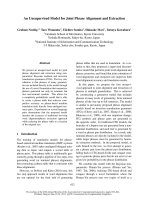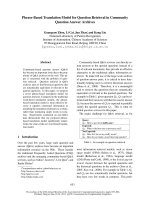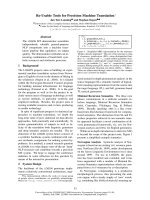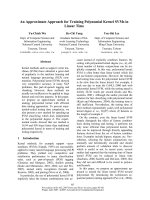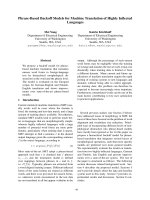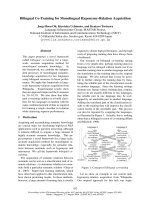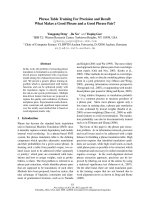Báo cáo khoa học: "Phrase Table Training For Precision and Recall: What Makes a Good Phrase and a Good Phrase Pair?" doc
Bạn đang xem bản rút gọn của tài liệu. Xem và tải ngay bản đầy đủ của tài liệu tại đây (197.24 KB, 8 trang )
Proceedings of ACL-08: HLT, pages 81–88,
Columbus, Ohio, USA, June 2008.
c
2008 Association for Computational Linguistics
Phrase Table Training For Precision and Recall:
What Makes a Good Phrase and a Good Phrase Pair?
Yonggang Deng
∗
, Jia Xu
+
and Yuqing Gao
∗
∗
IBM T.J. Watson Research Center, Yorktown Heights, NY 10598, USA
{ydeng,yuqing}@us.ibm.com
+
Chair of Computer Science VI, RWTH Aachen University, D-52056 Aachen, Germany
Abstract
In this work, the problem of extracting phrase
translation is formulated as an information re-
trieval process implemented with a log-linear
model aiming for a balanced precision and re-
call. We present a generic phrase training al-
gorithm which is parameterized with feature
functions and can be optimized jointly with
the translation engine to directly maximize
the end-to-end system performance. Multiple
data-driven feature functions are proposed to
capture the quality and confidence of phrases
and phrase pairs. Experimental results demon-
strate consistent and significant improvement
over the widely used method that is based on
word alignment matrix only.
1 Introduction
Phrase has become the standard basic translation
unit in Statistical Machine Translation (SMT) since
it naturally captures context dependency and models
internal word reordering. In a phrase-based SMT
system, the phrase translation table is the defining
component which specifies alternative translations
and their probabilities for a given source phrase. In
learning such a table from parallel corpus, two re-
lated issues need to be addressed (either separately
or jointly): which pairs are considered valid trans-
lations and how to assign weights, such as proba-
bilities, to them. The first problem is referred to as
phrase pair extraction, which identifies phrase pairs
that are supposed to be translations of each other.
Methods have been proposed, based on syntax, that
take advantage of linguistic constraints and align-
ment of grammatical structure, such as in Yamada
and Knight (2001) and Wu (1995). The most widely
used approach derives phrase pairs from word align-
ment matrix (Och and Ney, 2003; Koehn et al.,
2003). Other methods do not depend on word align-
ments only, such as directly modeling phrase align-
ment in a joint generative way (Marcu and Wong,
2002), pursuing information extraction perspective
(Venugopal et al., 2003), or augmenting with model-
based phrase pair posterior (Deng and Byrne, 2005).
Using relative frequency as translation probabil-
ity is a common practice to measure goodness of
a phrase pair. Since most phrases appear only a
few times in training data, a phrase pair translation
is also evaluated by lexical weights (Koehn et al.,
2003) or term weighting (Zhao et al., 2004) as addi-
tional features to avoid overestimation. The transla-
tion probability can also be discriminatively trained
such as in Tillmann and Zhang (2006).
The focus of this paper is the phrase pair extrac-
tion problem. As in information retrieval, precision
and recall issues need to be addressed with a right
balance for building a phrase translation table. High
precision requires that identified translation candi-
dates are accurate, while high recall wants as much
valid phrase pairs as possible to be extracted, which
is important and necessary for online translation that
requires coverage. In the word-alignment derived
phrase extraction approach, precision can be im-
proved by filtering out most of the entries by using
a statistical significance test (Johnson et al., 2007).
On the other hand, there are valid translation pairs
in the training corpus that are not learned due to
word alignment errors as shown in Deng and Byrne
(2005).
81
We would like to improve phrase translation ac-
curacy and at the same time extract as many as pos-
sible valid phrase pairs that are missed due to in-
correct word alignments. One approach is to lever-
age underlying word alignment quality such as in
Ayan and Dorr (2006). In this work, we present a
generic discriminative phrase pair extraction frame-
work that can integrate multiple features aiming to
identify correct phrase translation candidates. A sig-
nificant deviation from most other approaches is that
the framework is parameterized and can be opti-
mized jointly with the decoder to maximize transla-
tion performance on a development set. Within the
general framework, the main work is on investigat-
ing useful metrics. We employ features based on
word alignment models and alignment matrix. We
also propose information metrics that are derived
from both bilingual and monolingual perspectives.
All these features are data-driven and independent of
languages. The proposed phrase extraction frame-
work is general to apply linguistic features such as
semantic, POS tags and syntactic dependency.
2 A Generic Phrase Training Procedure
Let e = e
I
1
denote an English sentence and let
f = f
J
1
denote its translation in a foreign lan-
guage, say Chinese. Phrase extraction begins with
sentence-aligned parallel corpora {(e
i
, f
i
)}. We use
E = e
i
e
i
b
and F = f
j
e
j
b
to denote an English and
foreign phrases respectively, where i
b
(j
b
) is the po-
sition in the sentence of the beginning word of the
English(foreign) phrase and i
e
(j
e
) is the position of
the ending word of the phrase.
We first train word alignment models and will use
them to evaluate the goodness of a phrase and a
phrase pair. Let f
k
(E, F ), k = 1, 2, · · · , K be K
feature functions to be used to measure the quality
of a given phrase pair (E, F). The generic phrase
extraction procedure is an evaluation, ranking, fil-
tering, estimation and tuning process, presented in
Algorithm 1.
Step 1 (line 1) is the preparation stage. Begin-
ning with a flat lexicon, we train IBM Model-1 word
alignment model with 10 iterations for each trans-
lation direction. We then train HMM word align-
ment models (Vogel et al., 1996) in two directions
simultaneously by merging statistics collected in the
Algorithm 1 A Generic Phrase Training Procedure
1: Train Model-1 and HMM word alignment models
2: for all sentence pair (e, f ) do
3: Identify candidate phrases on each side
4: for all candidate phrase pair (E, F ) do
5: Calculate its feature function values f
k
6: Obtain the score q(E, F ) =
K
k=1
λ
k
f
k
(E, F)
7: end for
8: Sort candidate phrase pairs by their final scores q
9: Find the maximum score qm = max q(E, F )
10: for all candidate phrase pair (E, F ) do
11: If q(E, F ) ≥ qm − τ, dump the pair into the pool
12: end for
13: end for
14: Built a phrase translation table from the phrase pair pool
15: Discriminatively train feature weights λ
k
and threshold τ
E-step from two directions motivated by Zens et al.
(2004) with 5 iterations. We use these models to de-
fine the feature functions of candidate phrase pairs
such as phrase pair posterior distribution. More de-
tails will be given in Section 3.
Step 2 (line 2) consists of phrase pair evalua-
tion, ranking and filtering. Usually all n-grams up
to a pre-defined length limit are considered as can-
didate phrases. This is also the place where lin-
guistic constraints can be applied, say to avoid non-
compositional phrases (Lin, 1999). Each normalized
feature score derived from word alignment models
or language models will be log-linearly combined
to generate the final score. Phrase pair filtering is
simply thresholding on the final score by comparing
to the maximum within the sentence pair. Note that
under the log-linear model, applying threshold for
filtering is equivalent to comparing the “likelihood”
ratio.
Step 3 (line 14) pools all candidate phrase pairs
that pass the threshold testing and estimates the fi-
nal phrase translation table by maximum likelihood
criterion. For each candidate phrase pair which is
above the threshold, we assign HMM-based phrase
pair posterior as its soft count when dumping them
into the global phrase pair pool. Other possibilities
for the weighting include assigning constant one or
the exponential of the final score etc.
One of the advantages of the proposed phrase
training algorithm is that it is a parameterized pro-
cedure that can be optimized jointly with the trans-
82
lation engine to minimize the final translation errors
measured by automatic metrics such as BLEU (Pa-
pineni et al., 2002). In the final step 4 (line 15), pa-
rameters {λ
k
, τ } are discriminatively trained on a
development set using the downhill simplex method
(Nelder and Mead, 1965).
This phrase training procedure is general in the
sense that it is configurable and trainable with dif-
ferent feature functions and their parameters. The
commonly used phrase extraction approach based
on word alignment heuristics (referred as ViterbiEx-
tract algorithm for comparison in this paper) as de-
scribed in (Och, 2002; Koehn et al., 2003) is a spe-
cial case of the algorithm, where candidate phrase
pairs are restricted to those that respect word align-
ment boundaries.
We rely on multiple feature functions that aim to
describe the quality of candidate phrase translations
and the generic procedure to figure out the best way
of combining these features. A good feature func-
tion pops up valid translation pairs and pushes down
incorrect ones.
3 Features
Now we present several feature functions that we in-
vestigated to help extracting correct phrase transla-
tions. All these features are data-driven and defined
based on models, such as statistical word alignment
model or language model.
3.1 Model-based Phrase Pair Posterior
In a statistical generative word alignment model
(Brown et al., 1993), it is assumed that (i) a random
variable a specifies how each target word f
j
is gen-
erated by (therefore aligned to) a source
1
word e
a
j
;
and (ii) the likelihood function f (f , a|e) specifies a
generative procedure from the source sentence to the
target sentence. Given a phrase pair in a sentence
pair, there will be many generative paths that align
the source phrase to the target phrase. The likelihood
of those generative procedures can be accumulated
to get the likelihood of the phrase pair (Deng and
Byrne, 2005). This is implemented as the summa-
tion of the likelihood function over all valid hidden
word alignments.
1
The word source and target are in the sense of word align-
ment direction, not as in the source-channel formulation.
More specifically, let A
(j
1
,j
2
)
(i
1
,i
2
)
be the set of word
alignment a that aligns the source phrase e
j
1
i
1
to the
target phrase f
j
2
j
1
(links to NULL word are ignored
for simplicity):
A
(j
1
,j
2
)
(i
1
,i
2
)
= {a : a
j
∈ [i
1
, i
2
] iff j ∈ [j
1
, j
2
]}
The alignment set given a phrase pair ignores those
pairs with word links across the phrase boundary.
Consequently, the phrase-pair posterior distribution
is defined as
P
θ
(e
i
2
i
1
→ f
j
2
j
1
|e, f ) =
a∈A
(j
1
,j
2
)
(i
1
,i
2
)
f(a, f |e; θ)
a
f(a, f |e; θ)
.(1)
Switching the source and the target, we can obtain
the posterior distribution in another translation di-
rection. This distribution is applicable to all word
alignment models that follow assumptions (i) and
(ii). However, the complexity of the likelihood func-
tion could make it impractical to calculate the sum-
mations in Equation 1 unless an approximation is
applied.
Several feature functions will be defined on top of
the posterior distribution. One of them is based on
HMM word alignment model. We use the geometric
mean of posteriors in two translation directions as
a symmetric metric for phrase pair quality evalua-
tion function under HMM alignment models. Table
1 shows the phrase pair posterior matrix of the ex-
ample.
Replacing the word alignment model with IBM
Model-1 is another feature function that we added.
IBM Model-1 is simple yet has been shown to be
effective in many applications (Och et al., 2004).
There is a close form solution to calculate the phrase
pair posterior under Model-1. Moreover, word to
word translation table under HMM is more concen-
trated than that under Model-1. Therefore, the pos-
terior distribution evaluated by Model-1 is smoother
and potentially it can alleviate the overestimation
problem in HMM especially when training data size
is small.
3.2 Bilingual Information Metric
Trying to find phrase translations for any possible n-
gram is not a good idea for two reasons. First, due
to data sparsity and/or alignment model’s capabil-
ity, there would exist n-grams that cannot be aligned
83
f
1
f
2
f
3
1(that) 2(is) 34(what)
what’s that
e
1
e
2
e
1
1
e
2
1
e
2
2
H
BL
(f
j
2
j
1
)
f
1
1
0.0006 0.012 0.89 0.08
f
2
1
0.0017 0.035 0.343 0.34
f
3
1
0.07 0.999 0.0004 0.24
f
2
2
0.03 0.0001 0.029 0.7
f
3
2
0.89 0.006 0.006 0.05
f
3
3
0.343 0.002 0.002 0.06
H
BL
(e
i
2
i
1
) 0.869 0.26 0.70
Table 1: Phrase pair posterior distribution for the example
well, for instance, n-grams that are part of a para-
phrase translation or metaphorical expression. To
give an example, the unigram ‘tomorrow’ in ‘the day
after tomorrow’ whose Chinese translation is a sin-
gle word ‘’. Extracting candidate translations
for such kind of n-grams for the sake of improving
coverage (recall) might hurt translation quality (pre-
cision). We will define a confidence metric to esti-
mate how reliably the model can align an n-gram in
one side to a phrase on the other side given a par-
allel sentence. Second, some n-grams themselves
carry no linguistic meaning; their phrase translations
can be misleading, for example non-compositional
phrases (Lin, 1999). We will address this in section
3.3.
Given a sentence pair, the basic assumption is that
if the HMM word alignment model can align an En-
glish phrase well to a foreign phrase, the posterior
distribution of the English phrase generating all for-
eign phrases on the other side is significantly biased.
For instance, the posterior of one foreign phrase is
far larger than that of the others. We use the entropy
of the posterior distribution as the confidence metric:
H
BL
(e
i
2
i
1
|e, f ) = H(
ˆ
P
θ
HMM
(e
i
2
i
1
→ ∗)) (2)
where H(P ) = −
x
P (x) log P (x) is the entropy
of a distribution P (x),
ˆ
P
θ
HMM
(e
i
2
i
1
→ ∗) is the
normalized probability (sum up to 1) of the pos-
terior P
θ
HMM
(e
i
2
i
1
→ ∗) as defined in Equation 1.
Low entropy signals a high confidence that the En-
glish phrase can be aligned correctly. On the other
hand, high entropy implies ambiguity presented in
discriminating the correct foreign phrase from the
others from the viewpoint of the model.
Similarly we calculate the confidence metric of
aligning a foreign phrase correctly with the word
alignment model in foreign to English direction. Ta-
ble 1 shows the entropy of phrases. The unigram
of foreign side f
2
2
is unlikely to survive with such
high ambiguity. Adding the entropy in two direc-
tions defines the bilingual information metric as an-
other feature function, which describes the reliabil-
ity of aligning each phrase correctly by the model.
Note that we used HMM word alignment model to
find the posterior distribution. Other models such as
Model-1 can be applied in the same way. This fea-
ture function quantitatively captures the goodness of
phrases. During phrase pair ranking, it can help
to move upward phrases that can be aligned well
and push downward phrases that are difficult for the
model to find correct translations.
3.3 Monolingual Information Metric
Now we turn to monolingual resources to evaluate
the quality of an n-gram being a good phrase. A
phrase in a sentence is specified by its boundaries.
We assume that the boundaries of a good phrase
should be the “right” place to break. More generally,
we want to quantify how effective a word bound-
ary is as a phrase boundary. One would perform say
NP-chunking or parsing to avoid splitting a linguis-
tic constituent. We apply a language model (LM)
to describe the predictive uncertainty (P U) between
words in two directions.
Given a history w
n−1
1
, a language model specifies
a conditional distribution of the future word being
predicted to follow the history. We can find the en-
tropy of such pdf: H
LM
(w
n−1
1
) = H(P (·|w
n−1
1
)).
So given a sentence w
N
1
, the P U of the boundary be-
tween word w
i
and w
i+1
is established by two-way
entropy sum using a forward and backward language
model: P U(w
N
1
, i) = H
LMF
(w
i
1
) + H
LMB
(w
i+1
N
)
We assume that the higher the predictive uncer-
tainty is, the more likely the left or right part of the
word boundary can be “cut-and-pasted” to form an-
other reasonable sentence. So a good phrase is char-
acterized with high P U values on the boundaries.
For example, in ‘we want to have a table near the
window’, the P U value of the point after ‘table’ is
0.61, higher than that between ‘near’ and ‘the’ 0.3,
using trigram LMs.
With this, the feature function derived from
84
monolingual clue for a phrase pair can be defined
as the product of P Us of the four word boundaries.
3.4 Word Alignments Induced Metric
The widely used ViterbiExtract algorithm relies
on word alignment matrix and no-crossing-link as-
sumption to extract phrase translation candidates.
Practically it has been proved to work well. How-
ever, discarding correct phrase pairs due to incorrect
word links leaves room for improving recall. This
is especially true for not significantly large training
corpora. Provided with a word alignment matrix,
we define within phrase pair consistency ratio (WP-
PCR) as another feature function. WPPCR was used
as one of the scores in (Venugopal et al., 2003) for
phrase extraction. It is defined as the number of con-
sistent word links associated with any words within
the phrase pair divided by the number of all word
links associated with any words within the phrase
pair. An inconsistent link connects a word within
the phrase pair to a word outside the phrase pair. For
example, the WPPCR for (e
2
1
, f
2
1
) in Table 1 is 2/3.
As a special case, the ViterbiExtract algorithm ex-
tracts only phrase pairs with WPPCR is 1.
To further discriminate the pairs with higher WP-
PCR from those with lower ratio, we apply a Bi-
Linear Transform (BLT) (Oppenheim and Schafer,
1989) mapping. BLT is commonly used in sig-
nal processing to attenuate the low frequency parts.
When used to map WPPCR, it exaggerates the dif-
ference between phrase pairs with high WPPCR and
those with low WPPCR, making the pairs with low
ratio more unlikely to be selected as translation can-
didates. One of the nice properties of BLT is that
there is a parameter that can be changed to adjust
the degree of attenuation, which provides another di-
mension for system optimization.
4 Experimental Results
We evaluate the effect of the proposed phrase extrac-
tion algorithm with translation performance. We do
experiments on IWSLT (Paul, 2006) 2006 Chinese-
English corpus. The task is to translate Chinese ut-
terances in travel domain into English. We report
only text (speech transcription) translation results.
The training corpus consists of 40K Chinese-
English parallel sentences in travel domain with to-
Eval Set 04dev 04test 05test 06dev 06test
# of sentences 506 500 506 489 500
# of words 2808 2906 3209 5214 5550
# of refs 16 16 16 7 7
Table 2: Dev/test set statistics
tal 306K English words and 295K Chinese words.
In the data processing step, Chinese characters are
segmented into words. English text are normalized
and lowercased. All punctuation is removed.
There are five sets of evaluation sentences in
tourism domain for development and test. Their
statistics are shown in Table 2. We will tune training
and decoding parameters on 06dev and report results
on other sets.
4.1 Training and Translation Setup
Our decoder is a phrase-based multi-stack imple-
mentation of the log-linear model similar to Pharaoh
(Koehn et al., 2003). Like other log-linear model
based decoders, active features in our transla-
tion engine include translation models in two di-
rections, lexicon weights in two directions, lan-
guage model, lexicalized distortion models, sen-
tence length penalty and other heuristics. These fea-
ture weights are tuned on the dev set to achieve op-
timal translation performance using downhill sim-
plex method. The language model is a statistical
trigram model estimated with Modified Kneser-Ney
smoothing (Chen and Goodman, 1996) using only
English sentences in the parallel training data.
Starting from the collection of parallel training
sentences, we build word alignment models in two
translation directions, from English to Chinese and
from Chinese to English, and derive two sets of
Viterbi alignments. By combining word alignments
in two directions using heuristics (Och and Ney,
2003), a single set of static word alignments is then
formed. Based on alignment models and word align-
ment matrices, we compare different approaches of
building a phrase translation table and show the fi-
nal translation results. We measure translation per-
formance by the BLEU (Papineni et al., 2002) and
METEOR (Banerjee and Lavie, 2005) scores with
multiple translation references.
85
BLEU Scores
Table 04dev 04test 05test 06dev 06test
HMM 0.367 0.407 0.473 0.200 0.190
Model-4 0.380 0.403 0.485 0.210 0.204
New 0.411 0.427 0.500 0.216 0.208
METEOR Scores
Table 04dev 04test 05test 06dev 06test
HMM 0.532 0.586 0.675 0.482 0.471
Model-4 0.540 0.593 0.682 0.492 0.480
New 0.568 0.614 0.691 0.505 0.487
Table 3: Translation Results
4.2 Translation Results
Our baseline phrase table training method is the
ViterbiExtract algorithm. All phrase pairs with re-
spect to the word alignment boundary constraint are
identified and pooled to build phrase translation ta-
bles with the Maximum Likelihood criterion. We
prune phrase translation entries by their probabili-
ties. The maximum number of words in Chinese and
English phrases is set to 8 and 25 respectively for all
conditions
2
. We perform online style phrase train-
ing, i.e., phrase extraction is not particular for any
evaluation set.
Two different word alignment models are trained
as the baseline, one is symmetric HMM word align-
ment model, the other is IBM Model-4 as imple-
mented in the GIZA++ toolkit (Och and Ney, 2003).
The translation results as measured by BLEU and
METEOR scores are presented in Table 3. We notice
that Model-4 based phrase table performs roughly
1% better in terms of both BLEU and METEOR
scores than that based on HMM.
We follow the generic phrase training procedure
as described in section 2. The most time consuming
part is calculating posteriors, which is carried out in
parallel with 30 jobs in less than 1.5 hours.
We use the Viterbi word alignments from HMM
to define within phrase pair consistency ratio as dis-
cussed in section 3.4. Although Table 3 implies that
Model-4 word alignment quality is better than that
of HMM, we did not get benefits by switching to
Model-4 to compute word alignments based feature
values.
In estimating phrase translation probability, we
use accumulated HMM-based phrase pair posteriors
2
We chose large numbers for phrase length limit to build a
strong baseline and to avoid impact of longer phase length.
as their ‘soft’ frequencies and then the final trans-
lation probability is the relative frequency. HMM-
based posterior was shown to be better than treating
each occurrence as count one.
Once we have computed all feature values for all
phrase pairs in the training corpus, we discrimina-
tively train feature weights λ
k
s and the threshold
τ using the downhill simplex method to maximize
the BLEU score on 06dev set. Since the translation
engine implements a log-linear model, the discrim-
inative training of feature weights in the decoder
should be embedded in the whole end-to-end system
jointly with the discriminative phrase table training
process. This is globally optimal but computation-
ally demanding. As a compromise, we fix the de-
coder feature weights and put all efforts on optimiz-
ing phrase training parameters to find out the best
phrase table.
The translation results with the discriminatively
trained phrase table are shown as the row of “New”
in Table 3. We observe that the new approach is con-
sistently better than the baseline ViterbiExtract algo-
rithm with either Model-4 or HMM word alignments
on all sets. Roughly, it has 0.5% higher BLEU score
on 2006 sets and 1.5% to 3% higher on other sets
than Model-4 based ViterbiExtract method. Similar
superior results are observed when measured with
METEOR score.
5 Discussions
The generic phrase training algorithm follows an in-
formation retrieval perspective as in (Venugopal et
al., 2003) but aims to improve both precision and
recall with the trainable log-linear model. A clear
advantage of the proposed approach over the widely
used ViterbiExtract method is trainability. Under the
general framework, one can put as many features as
possible together under the log-linear model to eval-
uate the quality of a phrase and a phase pair. The
phrase table extracting procedure is trainable and
can be optimized jointly with the translation engine.
Another advantage is flexibility, which is pro-
vided partially by the threshold τ. As the figure
1 shows, when we increase the threshold by al-
lowing more candidate phrase pair hypothesized as
valid translation, we observe the phrase table size in-
creases monotonically. On the other hand, we notice
86
1 2 3 4 5 6 7 8 9 10 11 12 13 14 15
0.17
0.18
0.19
0.2
Threshold
Thresholding Effects
Translation Performance
0 5 10 15
5
5.5
6
6.5
Log10 of the number of Entries in the PhraseTable
BLEU
Phrasetable Size
Figure 1: Thresholding effects on translation perfor-
mance and phrase table size
that the translation performance improves gradually.
After reaching its peak, the BLEU score drops as the
threshold τ increases. When τ is large enough, the
translation performance is not changing much but
still worse than the peak value. It implies a balanc-
ing process between precision and recall. The final
optimal threshold τ is around 5.
The flexibility is also enabled by multiple con-
figurable features used to evaluate the quality of a
phrase and a phrase pair. Ideally, a perfect combina-
tion of feature functions divides the correct and in-
correct candidate phrase pairs within a parallel sen-
tence into two ordered separate sets. We use feature
functions to decide the order and the threshold τ to
locate the boundary guided with a development set.
So the main issue to investigate now is which
features are important and valuable in ranking can-
didate phrase pairs. We propose several informa-
tion metrics derived from posterior distribution, lan-
guage model and word alignments as feature func-
tions. The ViterbiExtract is a special case where
a single binary feature function defined from word
alignments is used. Its good performance (as shown
in Table 3) suggests that word alignments are very
indicative of phrase pair quality. So we design com-
parative experiments to capture word alignment im-
pact only. We start with basic features that in-
clude model-based posterior, bilingual and mono-
lingual information metrics. Its results on different
test sets are presented in the “basic” row of Table 4.
We add word alignment feature (“+align” row), and
Features 04dev 04test 05test 06dev 06test
basic 0.393 0.406 0.496 0.205 0.199
+align 0.401 0.429 0.502 0.208 0.196
+align BLT 0.411 0.427 0.500 0.216 0.208
Table 4: Translation Results (BLEU) of discriminative
phrase training approach using different features
75K
250K
132K
PP1
PP3
PP2
Model−4
New
Features 04dev 04test 05test 06dev 06test
PP2 0.380 0.395 0.480 0.207 0.202
PP1+PP2 0.380 0.403 0.485 0.210 0.204
PP2+PP3 0.411 0.427 0.500 0.216 0.208
PP1+PP2+PP3 0.412 0.432 0.500 0.217 0.214
Table 5: Translation Results (BLEU) of Different Phrase
Pair Combination
then apply bilinear transform to the consistency ratio
WPPCR as described in section 3.4 (“+align BLT”
row). The parameter controlling the degree of atten-
uation in BLT is also optimized together with other
feature weights.
With the basic features, the new phrase extraction
approach performs better than the baseline method
with HMM word alignment models but similar to
the baseline method with Model-4. With the word
alignment based feature WPPCR, we obtain a 2%
improvement on 04test set but not much on other
sets except slight degradation on 06test. Finally, ap-
plying BLT transform to WPPCR leads to additional
0.8 BLEU point on 06dev set and 1.2 point on 06test
set. This confirms the effectiveness of word align-
ment based features.
Now we compare the phrase table using the pro-
posed method to that extracted using the baseline
ViterbiExtract method with Model-4 word align-
ments. The Venn diagram in Table 5 shows how the
two phrase tables overlap with each other and size
of each part. As expected, they have a large num-
ber of common phrase pairs (PP2). The new method
is able to extract more phrase pairs than the base-
line with Model-4. PP1 is the set of phrase pairs
found by Model-4 alignments. Removing PP1 from
the baseline phrase table (comparing the first group
of scores) or adding PP1 to the new phrase table
87
(the second group of scores) overall results in no or
marginal performance change. On the other hand,
adding phrase pairs extracted by the new method
only (PP3) can lead to significant BLEU score in-
creases (comparing row 1 vs. 3, and row 2 vs. 4).
6 Conclusions
In this paper, the problem of extracting phrase trans-
lation is formulated as an information retrieval pro-
cess implemented with a log-linear model aiming for
a balanced precision and recall. We have presented
a generic phrase translation extraction procedure
which is parameterized with feature functions. It
can be optimized jointly with the translation engine
to directly maximize the end-to-end translation per-
formance. Multiple feature functions were investi-
gated. Our experimental results on IWSLT Chinese-
English corpus have demonstrated consistent and
significant improvement over the widely used word
alignment matrix based extraction method.
3
Acknowledgement We would like to thank Xi-
aodong Cui, Radu Florian and other IBM colleagues
for useful discussions and the anonymous reviewers
for their constructive suggestions.
References
N. Ayan and B. Dorr. 2006. Going beyond AER: An
extensive analysis of word alignments and their impact
on MT. In Proc. of ACL, pages 9–16.
S. Banerjee and A. Lavie. 2005. METEOR: An auto-
matic metric for MT evaluation with improved cor-
relation with human judgments. In Proc. of the ACL
Workshop on Intrinsic and Extrinsic Evaluation Mea-
sures for Machine Translation and/or Summarization,
pages 65–72.
P. Brown, S. Della Pietra, V. Della Pietra, and R. Mer-
cer. 1993. The mathematics of machine transla-
tion: Parameter estimation. Computational Linguis-
tics, 19:263–312.
S. F. Chen and J. Goodman. 1996. An empirical study of
smoothing techniques for language modeling. In Proc.
of ACL, pages 310–318.
Y. Deng and W. Byrne. 2005. HMM word and phrase
alignment for statistical machine translation. In Proc.
of HLT-EMNLP, pages 169–176.
3
By parallelism, we have shown the feasibility and effec-
tiveness (results not presented here) of the proposed method in
handling millions of sentence pairs.
H. Johnson, J. Martin, G. Foster, and R. Kuhn. 2007. Im-
proving translation quality by discarding most of the
phrasetable. In Proc. of EMNLP-CoNLL, pages 967–
975.
P. Koehn, F. Och, and D. Marcu. 2003. Statistical phrase-
based translation. In Proc. of HLT-NAACL, pages 48–
54.
D. Lin. 1999. Automatic identification of non-
compositional phrases. In Proc. of ACL, pages 317–
324.
D. Marcu and D. Wong. 2002. A phrase-based, joint
probability model for statistical machine translation.
In Proc. of EMNLP, pages 133–139.
J. A. Nelder and R. Mead. 1965. A simplex method
for function minimization. Computer Journal, 7:308–
313.
F. J. Och and H. Ney. 2003. A systematic comparison of
various statistical alignment models. Computational
Linguistics, 29(1):19–51.
F. J. Och, D. Gildea, and et al. 2004. A smorgasbord of
features for statistical machine translation. In Proc. of
HLT-NAACL, pages 161–168.
F. Och. 2002. Statistical Machine Translation: From
Single Word Models to Alignment Templates. Ph.D.
thesis, RWTH Aachen, Germany.
A. V. Oppenheim and R. W. Schafer. 1989. Discrete-
Time Signal Processing. Prentice-Hall.
K. Papineni, S. Roukos, T. Ward, and W. Zhu. 2002.
Bleu: a method for automatic evaluation of machine
translation. In Proc. of ACL, pages 311–318.
M. Paul. 2006. Overview of the IWSLT 2006 evaluation
campaign. In Proc. of IWSLT, pages 1–15.
C. Tillmann and T. Zhang. 2006. A discriminative global
training algorithm for statistical MT. In Proc. of ACL,
pages 721–728.
A. Venugopal, S. Vogel, and A. Waibel. 2003. Effective
phrase translation extraction from alignment models.
In Proc. of ACL, pages 319–326.
S. Vogel, H. Ney, and C. Tillmann. 1996. HMM based
word alignment in statistical translation. In Proc. of
the COLING.
D. Wu. 1995. An algorithm for simultaneously bracket-
ing parallel texts by aligning words. In Proc. of ACL,
pages 244–251.
K. Yamada and K. Knight. 2001. A syntax-based statis-
tical translation model. In Proc. of ACL, pages 523–
530.
R. Zens, E. Matusov, and H. Ney. 2004. Improved word
alignment using a symmetric lexicon model. In Proc.
of COLING, pages 36–42.
B. Zhao, S. Vogel, M. Eck, and A. Waibel. 2004. Phrase
pair rescoring with term weighting for statistical ma-
chine translation. In Proc. of EMNLP, pages 206–213.
88

